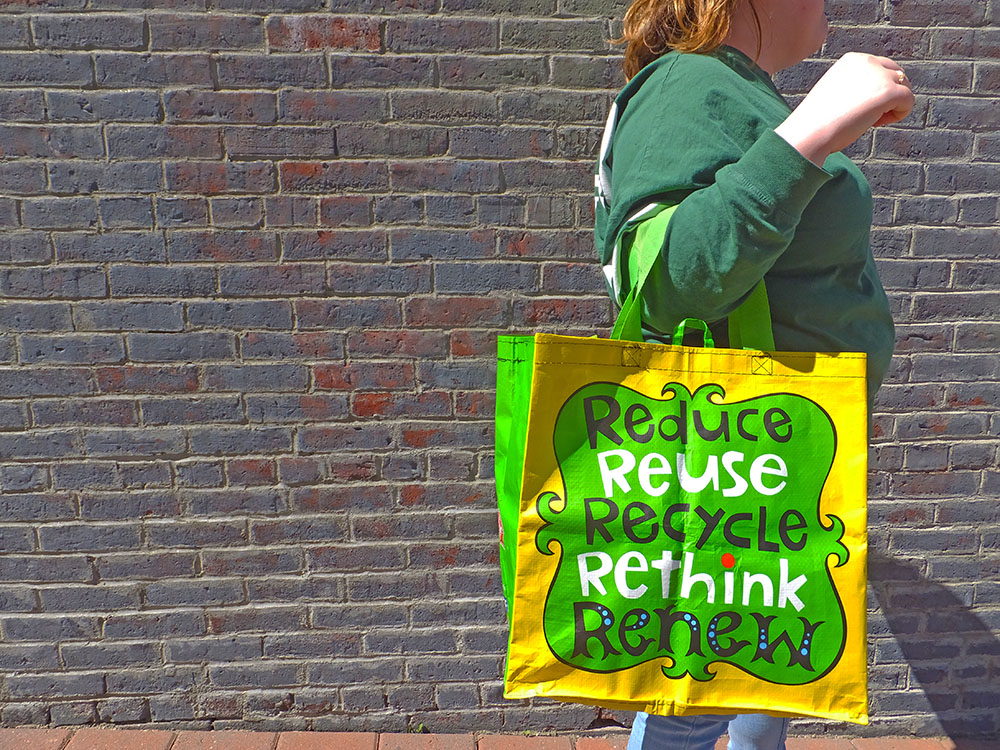I tried to make a no-sew t-shirt bag. Here’s how it went.
Over my four years of high school theater, I accumulated over a dozen show shirts, each screen-printed with a student-drawn show poster and the performance dates. Even though they each cost $10 and rendered the wearer as a living ad-plastered city bus, I wore the shirts proudly, even after the performances had passed.
When I moved to New York City for college, I self-consciously wondered whether it might be passé (or worse — dorky) to wear my non-professional theater garb around campus. I gathered my show shirts in a plastic bag and left them in the basement to deal with later.
When I came home for Christmas, they were gone. My mom mistook the bag for trash and “accidentally” threw them away.
I was upset for sentimental reasons, but also because it seemed like an enormous waste to just chuck perfectly good (if a little lovingly worn) t-shirts. Even in the early stages of my sustainability fanaticism (we all go through different journeys in college, don’t judge mine), I knew those shabby shirts could have been used as rags, pillowcases — or even to create a no-sew t-shirt bag battalion, nullifying my need to ever buy reusable bags again.
I knew then that between the resources used to create the shirts (at such a low price point, no less) meant that the environmental cost of my t-shirts was likely quite higher than what I paid for them. Simply throwing them away — especially when there are so many ways to upcycle t-shirts and extend the life of those materials — rubbed salt into that sustainability wound.
Add that to the fact that a number of studies have revealed that reusable bags can be less eco-friendly than their single-use plastic counterparts when considering the environmental impact of their production compared to their use and disposal.

Reusable bags may reduce plastic waste, but that they actually need to be reused (and not just sit in the trunk of your car) for their environmental cost to be worthwhile. Bags that are made from repurposed materials — ones that have already contributed to their useful life in a different way — are even more likely to have a net positive planetary impact.
Making a no-sew t-shirt bag helps reduce textile waste and plastic waste. Plus, it seems much more likely that you’ll remember to actually use a bag that has sentimental value that you made with your own two hands. Two birds: fear my one stone.
Now that I am moving to a new, more professional stage of my adulthood (she wrote, as she tried to select which silly video clips to include along with theme song), I have once again accumulated a number of t-shirts with lots of memories and little daily use. In honor of the high school show shirt bags that could have been, I decided to learn how to turn a few into quick, handy no-sew t-shirt bags.
Learning to try
Even though I recently purchased a sewing machine for myself (I’m a short, curvy girl, and it is so easy to hem pants when you have a little mechanical help), I wanted to try a no-sew t-shirt bag. Sewing machines can be prohibitively expensive, so not everyone has one, but this DIY should be accessible to everyone. Plus, my hand sewing is embarrassingly bad.
I chose this DIY from Mommypotamus because the finished products pictured on the blog looked both cute and structurally-sound.

When I went home for Thanksgiving, I dug two old t-shirts out of my dresser — a bright green one from a college open house event, and another from a campaign I worked on when I lived in Washington, D.C. — to bring back to Maine. My mom, apparently, has since learned not to touch my old clothes, no matter how ratty and unflattering they may be.
I purchased a pair of fabric scissors (my scissor skills are bad enough already, so I might as well wield a sharp blade to help me along), but a sharp pair of regular scissors would suffice for most thin t-shirt fabric. I also grabbed a colored pencil to help mark where I would be cutting so my no-sew t-shirt bag would be as even as possible.
A trying experience
For those of you who don’t know: fabric scissors are magic. They cut straight and evenly through my stretchy t-shirt like a knife through butter.
The bag “handles,” formed when I cut the sleeves and collar off my shirt, seemed a bit structurally unsound, but I decided to wait until I tested the bag to pass any judgment. Without these elements, I could have worn my old t-shirt as an awkwardly-shaped muscle shirt and left it at that, but I decided to continue with my DIY commitment.
I sized the bottom based on the size of another reusable bag I had (though I think I actually would have sized it larger given the opportunity to do it again) and marked the line to which I would cut the vertical strips.
The most challenging part was tying the strips at the bottom of the no-sew t-shirt bag (or not-yet-bag) so that there were no gaps. Gaps are the enemy of heavy groceries, after all.
The instructions explained that, after forming three knots at the end of the fabric strip row, the leftmost strand from the middle knot should be tied to the adjacent strand in the left knot, and vice versa. After you tie the next knot in the series, the rightmost strand of the rightmost knot — as of yet, untethered — should be tied to its neighboring strand in the new knot, and so on until all the strands are tied.
At first, my clumsy fingers couldn’t figure out the pattern. I misread the instructions initially and I kept retrying the one same strand all the way over until it was nothing but a nub. At points, I thought it might have just been easier to suck it up and sew the bag instead of weaving together the knots.
After a few tries, though, I got the hang of it and developed a relaxing rhythm. Once I was done, the bottom seemed pretty structurally sound, and I quickly whipped up another bag to test.

I went to Hannaford to pick up some ingredients for my contribution to the office holiday party (I made coleslaw) and to my book club (key lime pie tartlets). The bagger was hesitant to use my no-sew t-shirt bags, especially for eggs and glass Dijon mustard jar (I passed him a store-bought reusable bag for those).
All the produce and some canned goods, though, went into my no-sew t-shirt bags. There was some dramatic stretching and sagging — I was certain on my walk bag to the car that I would have a can of condensed milk wiggle its way between the knots and find its way to the asphalt — but my DIY bags held up. The thought also occurred to me, as the bottom of my bag accumulated cabbage condensation, that these no-sew t-shirt bags would be much easier to wash than their stiff, plasticky store-bought counterparts.
Successfully making a no-sew t-shirt bag that I can use every day won’t bring my high school theater shirts back. In their memory, though, I can now ensure that no t-shirt of mine shall ever meet such an ignoble fate again.
My tried-and-true takeaways
No-sew t-shirt bags are easy to make and fairly durable, though admittedly they do not quite have the structural integrity of other reusable bags. I do not know if I would use a no-sew t-shirt bag for bulk shopping, but it will definitely be useful — and turn the heads of other upcycling aficionados — at a farmers market for produce.

Functionality aside, making a no-sew t-shirt bag is a fun way to preserve old memories while making your daily life a little more sustainable.
